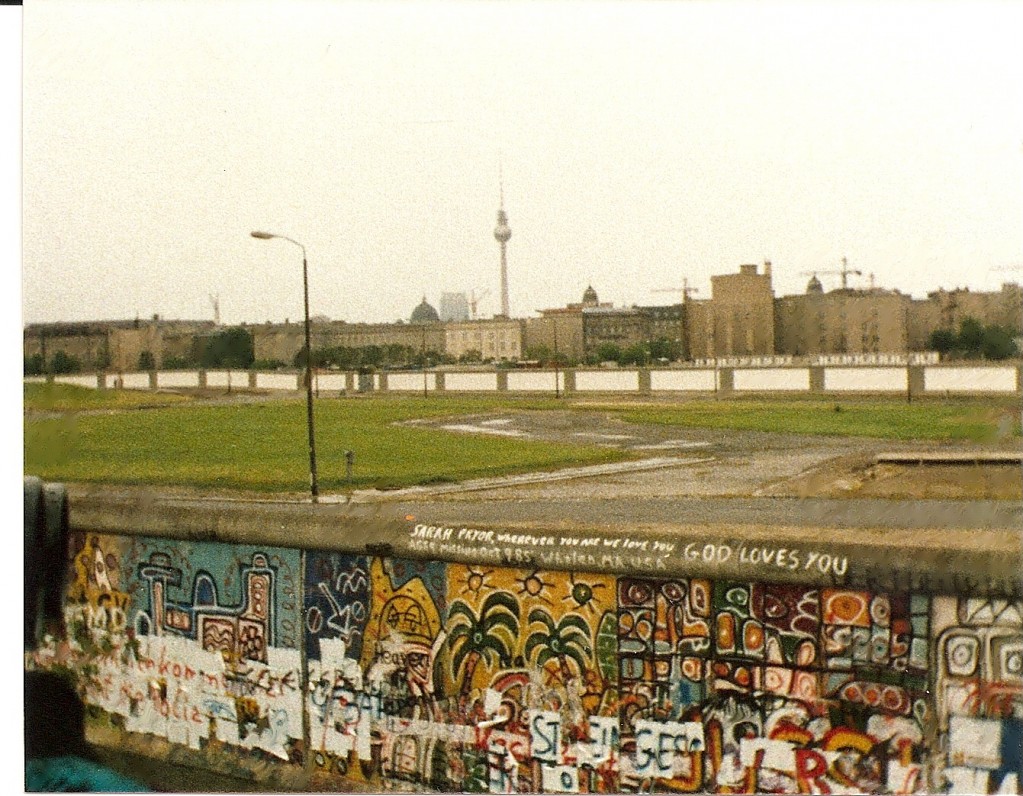 Looking east towards Alexanderplatz and its famous television tower, East Berlin City Center
Looking east towards Alexanderplatz and its famous television tower, East Berlin City Center
We are rapidly approaching the 20th anniversary of the fall of the Berlin wall, the most emblematic event of the collapse of communism in Europe, and of its ensuing collapse in the Soviet Union itself.
This will take place on November 9, 2009. The symbolic import, not to mention the material and psychosocial consequences of this event for both Europe and the world, cannot be underestimated. And it will take historians of future generations to clear the debris and construct a viable narrative of the period. One thing is certain however, the events that led up to 1989 and those that followed created the first great geopolitical paradigm shift since the First World War and the October Revolution, ending alignments and misalignments, ending a century of war, both hot and cold and wars of proxy (often fought in the aftermath of decolonization), and provoking the implosion of the 20th century’s two principal economic systems (or perhaps more accurately put, marking the definitive end of one, and the beginning of the end of the other). The interregnum that followed 1989, was short-lived. Communist economic policies collapsed with communism itself; the western free market economic system (partly through its hubristic response to the collapse of the command and control economy of the Soviet Union and the Eastern bloc countries) would take another two decades to burst its bubble. Meanwhile, by 2001, twelve years after the fall of the Berlin wall, a new brand of ideological division on a global scale, one that had been gathering force ever since the Soviet retreat from Afghanistan, suddenly became painfully concrete. Similar to the continuum between the first two world wars, the first Gulf War, predating September 11th, which was followed by the invasion of first Afghanistan and then Iraq should be seen as parts of the same event, the second war arising out of the unfinished business of the first, and, as well, a new interventionist agenda in Washington, which we now know was already in the works before September 11, but became a kind of juggernaut afterwards. The rise of El-Qaeda’s extremist ideology was already beginning to underpin the West’s anxiety over oil. The events of September 11th provided concrete proof, as though any were needed, that we were facing a formidable enemy and tipped us into remobilization in the Gulf. Militarily, President Obama’s recent election, based on a platform of change, has changed nothing. The drawdown in Iraq has been revised several times and still seems more contingent upon events on the battlefield than any firm date set by Washington, and rather than a withdrawal from the region, as though that were even conceivable, what is really occurring is a shifting of fronts and a relocation of resources back to Afghanistan and most likely into Pakistan, as the national governments of both countries continue to crumble and Taliban/Al-Qaeda forces push ever closer to Islamabad. The Thirty Years War of the 21st century looks set to continue. Except in this case it will be financed by China, who owns most of the United States debt, nearly one trillion dollars of it. The British Empire collapsed in similar fashion, as the world’s hired gun, even as it ran out of money to pay for bullets.
All this by way of a short introduction to one poet’s observations on how art functions in times of duress.
***
Roughly two weeks ago (on the 21st of April) I came across an article in my daily newspaper with the following title: O Muro de Berlim vai ser restaurado pelos artistas que o pintaram há 20 anos (The Berlin Wall Will Be Restored by the Artists that Painted it Twenty Years Ago). As a sometime resident of Berlin, and a self-declared Wallist, this caught my attention.
What is a Wallist? This is a term I devised for someone (namely myself) who was obsessed, not with the wall, since it was no longer there, but with the space left in its wake – at the time a sandy, weed-cluttered corridor. In 1992, it was still possible to follow the “death strip” left by the dismantling, a process which was just being completed when I made my first trip to Berlin. As you walked along, West Berlin was on the right, and East Berlin on the left (or vice versa, depending on which direction you took). These were two distinctly different worlds in terms of architecture, mood, and what photographers call “grayscale”, the gradations of which I worked out in my notebook. I would start out from Kreuzberg, where I lived right across the street from the swimming pool and Görlitzer park, where the old Görlitzer Bahnhof once stood, gateway to the East and the principal rail route to Vienna – hence the name of my street, Weiner Strasse. The railway station was bombed into scattered bricks on the 3rd of February, 1945 during raids that left 3,255 people dead or missing and over 119,000 homeless in the surrounding Kreuzberg district.” Görlitzer Bahnhof was re-opened, in makeshift form, by June, a month after the fall of Berlin. Yet, as relations between East and West chilled and it was not longer tenable for a Western station to operate on an Eastern line, it was finally closed to passenger trains by the GDR in April of 1951, although freight still passed between East and West until 1986, where there was a border crossing point on the bridge over the Landwehrkanal at the end of the park.
In 1992, there were no train tracks in the park itself, though it was easy to identify the line they followed. But on the other side of the canal, in Treptow, the adjoining East Berlin neighborhood, the tracks were still there, rusted in disuse next to an abandoned factory collapsing, brick by brick. From my house, I would cross the rickety bridge, or follow the canal into Treptow, where I would pick up the line that the wall had left.
This ghost strip was, for me, a place of the imagination, a nullity so rife with the echoes of postwar history that the air seemed to crackle in distress. I set myself to studying the topographies of this vast, flat, suddenly “united” city, venturing at times into the Eastern neighborhoods, and at other times into the Western ones. I sketched, took notes, photographed. I had already lived in a divided Europe for five years. I pleaded with this gash (pleaded with its random piles of wall rubble, the lonely watch tower no longer watching anything and with the strange cut-off houses) to reveal itself to me. And, as poets do, I became the actor in that slow process of revelation, coaxing secrets out of vanished stone.
Having watched the events of 1989 on television, far away in Portugal, the toppling of the GDR had remained somewhat abstract to me. Now that I was in situ the negated enormity of the obliterated wall began to whisper. The Soviet Union had collapsed only two months earlier. The acrid sting of heating coal was still palpable in the winter air. I had had to learn how to light and stoke a coal fire in one of those large ceramic stoves that occupied a central place in every Berlin apartment, East or West. The city was, of course, still divided. The Germans had a name for this: “Mauer im Kopf”, which means “the wall in the head.” This division was glaringly visible. You could see it most blatantly in the way the Ossis dressed as you took the U-Bann into East Berlin, in the shock that was etched on their faces. Lives in the East were coming undone. Some left for the West as soon as they could, others (my friend Misha, for instance, a painter) escaped to Moscow – though he was soon back in East Berlin. Theirs was a kind of naiveté, the East Germans, and yet that was balanced against a toughness of spirit and the sense of fatality that comes of having been stripped of something essential (in their case, time). They reminded me of the Portuguese in a certain way, geographically isolated and only 15 years past their own 40 odd year experience of dictatorship. All of this was brought into high relief crossing west to east.
The first time a saw the most extensive section of remaining wall was when we were leaving for a reading tour, first to Leipzig, then to Halle and Jena. It was still only about 8:30 in the morning, but Max, my editor, wanted to stop in Alexanderplatz to stock up on supplies for the journey east. I waited by the car (my little Renault), illegally parked, while Max, Misha and Pontus went to get what was needed, which turned out to be a bottle of vodka and a case of beer, some sausage and bread and big bag of potato chips. Once we were on our way, bottles opened, conversation roaring, Max started shouting directions from the back seat as we sped along Mühlenstrasse, which runs along the east side of the river Spree. The wall suddenly loomed into site, covered with mural paintings and graffiti, before ending abruptly about a kilometer and half later at Oberbaumbrücke, one of Berlin’s loveliest bridges, with its red brick turrets.
I learned later that this was known as the East Side Gallery, supposedly the world’s largest open-air gallery. This is the section of the wall that will be restored, according to the article in O Público. All of the murals and graffiti will be removed, the underlying cement reinforced and then the whole strip will be repainted under the direction of Theirry Noir, one of the original West Side wall painters, by the original artists, and then covered with a graffiti proof varnish, an irony which cannot (to indulge in the obvious pun) be varnished over.
I haven’t been to Berlin for about three years. During my longest sojourns between 1993 and 2005 I lived in East Berlin in Friedrichshain, right off one of its central avenues, Karl-Marx-Allee, on Richard-Sorge-Strasse. When I came across this article in my daily newspaper, I thought back to that first morning in February 1992. What had bothered me was that the murals and the graffiti were on the wrong side. I realized immediately that this seemingly Holy Scripture had been scripted post-89. The authentic writing on the wall had occurred on the other side, the West Berlin side. The East Side Gallery post-dated the Cold War. It was a species of mimicry. This section of the wall should have been grey. Grey with white panels, a page on which it was illegal to write.
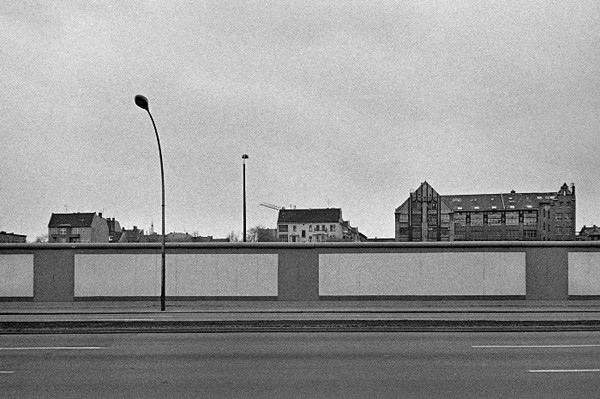
Writing (to be distinguished from proto-writing) seems to have appeared roughly five thousand years ago in Samaria and Egypt. The technology involved stone “tablets”, and later clay, on which business records were kept, such as transactions of property, the sale of grains and the production of beer; the first agrarian societies recorded their relationships with their cohorts on portable (though heavy) pages. Of course, at the time, this practice represented an advanced technology, a very distant relative of cave paintings and other representational art and symbol based inscriptions; imagine the distance between incunabula and hypertext, then multiply it by one hundred. The lives of individuals prospered with the new scripts, the private life (and the legal accumulation of wealth) was being invented with the codification of spoken language.
The day I came across this article, I was just finishing up a translation of a new film, a documentary on the lifework of the Portuguese artist Bartolomeu Cid, a painter and engraver who spent most of his working life in London. It’s a fantastic film, a series of interviews with Bartolomeu, Paula Rego, Helder Macedo and others who worked with them, most of them associated with the famous Slade School of Art.
What most struck me about Bartolomeu Cid’s work was how the brute physicality of the process produced such delicate, simple and yet highly articulate results. He would combine drawing with images, poems would appear, by Fernando Pessoa and others, fragmented and half erased. Over time an evolving vocabulary inscribed onto copper plates or stone began to emerge. Many of the finished engravings looked like palimpsests that contained the whole history of writing, from the pictographic to modern cursive scripts and everything in between.
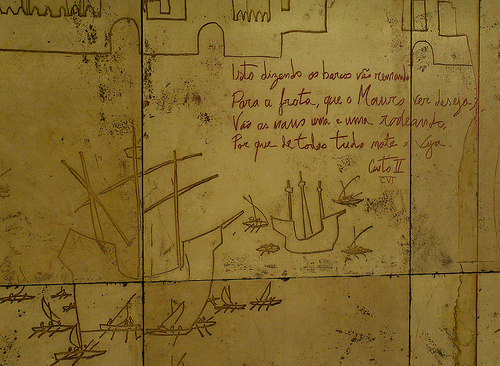
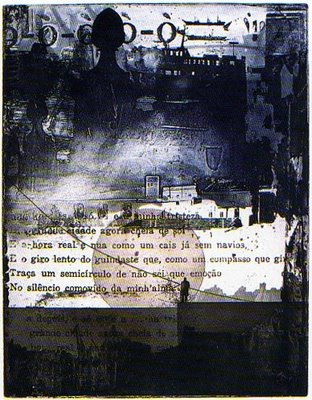
I kept asking myself, as I worked through the seventy-page script, why Barotlomeu might have been drawn towards engraving, away from painting. His own explanation was that it was the influence of one of his professors, the landscape painter William Townsend who, upon seeing his monochromatic watercolors of London street life, life along the banks of the Thames, his river scenes with their tugboats and bridges, told him to go and see Mr. Gross [Anthony Gross], who promptly sent him off to Drury

Anthony Gross
Lane to buy a copper plate, in engraver’s terminology, the “matrix.” “And I bought a plate, which I still have, and went back and made my first engraving. I made it in October of 1956. One of the best engravings that I made during the period when I was a student. It was called “City Lights.” I robbed the title from Chaplin.”
But perhaps Bartolomeu was already predisposed, because of his obvious love of literature. There is something in the engraver’s art that calls up the history of script. It was William Blake who invented relief printing, which runs contrary to the engraver’s instincts by switching the role of the negative and positive aspects of the matrix. Relief printing, according to Lauren Druss, “uses the raised surface of a matrix to create an image (by removing the negative spaces.)” Blake was looking for a way to combine texts with images. Bartolomeu Cid might never have ventured across the channel from France to England were it not for a book he came across in Paris, and his love for the French poet Prévert.
“And I picked out one from among the other books that was called Charms of London, photographs by Izis, texts by Prévert, who was my man at the time. These days no one here knows who Prévert was, but all of us recited Prévert. And it was all black, the photographs were all black and white. And I saw a black city, which played off what I was doing. And it was more through intuition, and I asked myself ‘What’s happening,’ and I told myself really, ‘Paris must be finished, used up, nothing seems new to me,’ but in London, I found the English neo-romantics, Nash, Sutherland, these men of the period, John Piper, in some collections of monographs by Penguin about English Artists. And that interested me. There was a certain aggression, a sharpness to things, and a darkness. And then I see the book by Prévert and I said ‘This is what I want.’ And I picked up the book, and I read the whole thing, and I wrote to Slade.”
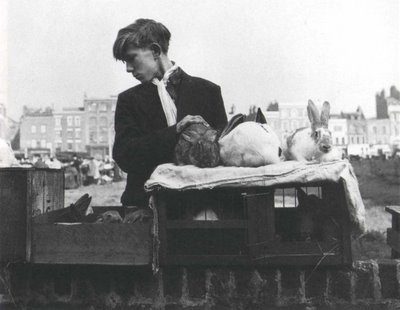
Izis Bidermanas, The Rabbit Seller
Theirry Noir, a young French artist, moved to West Berlin in 1982, attracted by the music scene; David Bowie and Iggy Pop were both Berlin residents at the time, which he mentions in a short biographical article. By the early 1980’s, after work on what is called the “forth generation” wall had been finished, graffiti started appearing here and there, making a mockery of East German ingenuity. Ironically, it was the technological advances in materials, namely the quality of the cement that allowed the graffiti artists and painters to advance their work. Previously, the quality of the stone blocks used in the wall’s construction had not provided the surface needed for large-scale painting. Theirry and fellow French artist Christophe Bouchet started to paint the three-meter high wall in April of 1984. Already the accumulating graffiti around Potsdamerplatz, Checkpoint Charlie, Brandenburger Tor and in Kreuzberg were changing the wall into a tourist attraction. Noir describes the situation in his short article:
“Noir and Bouchet, 2 young French men, who had been living 2 years close to the Berlin wall, felt the need to do something against this boring wall. A sort of physical reaction against the pressure of the daily life near the Berlin wall. The back of their house at Mariannenplatz was five meters in front of the wall. Their house was the first squatted house on December the 4th, 1971. It was called the "Georg von Rauch house" dedicated to the demonstrator killed by the police, the same day.”
Just as with artists and writers working on the other side, and throughout the Eastern Block and the Soviet Union, a degree of stealth was built into the wall painters’ endeavors. Their work was conducted against a backdrop of danger. More than simply decorating a “boring wall”, they were engaging in a highly illegal activity, codified in the statutes of East German law. An often forgotten fact is that the whole edifice was on East German soil and thus belonged to the GDR, even the surface that faced West Berlin. This perimeter, according to Theirry, in another article, had been constructed five meters within GDR territory, which allowed Honecker’s border guards, who followed a shoot-to-kill policy, to climb over the wall whenever they wanted.
In the article noted above Theirry describes just such a run-in. They were all set to screw a large, old and ornate door onto the wall, and a local television station was there to film them. But suddenly, when someone noticed that an East German guard had poked his head over the wall, everyone involved, artists and television crew pulled back. The scene that ensued speaks directly to the high Cold War stakes in place at this time, and encapsulates the danger of making art in certain circumstances:
“And then, sure enough, we saw the head of a GDR border guard just above the Wall. The TV crew stopped filming right away. Bouchet and I took our paint, brushes and drills back to the atelier. After the TV crew had left, four GDR border guards used a metal ladder to climb up the Wall and sit on top. Two of them had machine guns. The third was the boss, and there was a photographer, too. As soon as all four of them were sitting on top of the Wall, they pulled the ladder up from the no-man’s-land in the “East” and set it down on the west side of the Wall. The first to come down from the Wall was one of the guards with a machine gun. He secured the position and was followed by the boss, the photographer and the second machine-gun toting guard. While he was still sitting on the Wall, the second guard had kept his machine gun aimed at the others the entire time. We got the distinct impression that they were watching each other very carefully so as to prevent a possible escape attempt. In other words, it looked like they didn’t trust each other at all.”
***
What first drew these two seemingly unconnected events together in my mind – the film about Bartolmeu Cid, and the newspaper article on the East Side Gallery – had to do with the contexts in which art is made and how the palimpsestic nature of the murals and the writing on the Berlin Wall seemed to share certain qualities with the engravings and lithographs (done on copper plating and stone) of Bartolomeu Cid – the “matrix” was similar. And finally, perhaps more vaguely, it made me wonder about the uses art is put to after the fact of its production.
All of the artists I discuss worked in the shadow of dictatorships. Cid’s early career nearly overlapped the duration of the Portuguese Novo Estado under Salazar, a police state that shared characteristics (though not political alignments) with the East German Regime. Both Cid and Noir were exiled artists whose work confronted the arduous political realities of a Europe that was very much more divided then than it is today. Trying to understand those divisions occupied me fully in Berlin, just as do the traces of the Novo Estado, which live on in the mentalities of the Portuguese and many of the bureaucratic structures of the modern democratic state. Lastly both states, the unified Germany and the EU-integrated Portugal tend to use the art products of earlier periods, whether it was an art of dissent, or art of a more a-political nature (painted, written or sculpted in an atmosphere of state repression, or, indeed, in exile) to mark and memorialize their progress, as states, towards democracy.
The East Side Gallery in Berlin is an obvious pedagogical attempt (Theirry Noir says so himself) by the state to memorialize its past and to educate its citizens in the art of memory. And yet, it is an entirely ersatz version of the real thing, created, as I say above, after the collapse of the East German State and after the elimination of most of the Berlin wall. It has absolutely nothing to do with the original context and the pressure under which West Berlin artists worked, even though some of these artists,
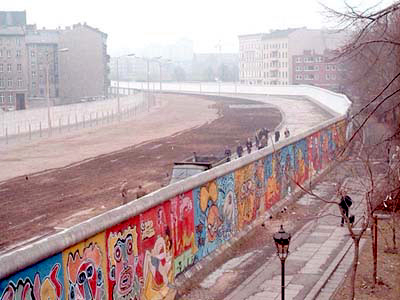
Divided Berlin, looking west to east
Noir included, kept on painting on the wrong side, once they were able to freely cross the border between West and East Berlin. Creating a monument out of the East Side Gallery based, as it is, on a misrepresentation of history is exactly the method that fascist and totalitarian regimes employ to enforce power and to educate through ideology, to create obedience and to stifle questioning. I would prefer that the authorities let the East Side Gallery crumble gracefully into oblivion rather than using it to represent a terrifying period of history in which it played – in its painted form – no part at all.
notes:
http://en.wikipedia.org/wiki/Berlin_Görlitzer_Bahnhof
Midas Filmes - www.midas-filmes.pt (translations by the author).
http://academic.evergreen.edu/curricular/incisiveline/handouts/printresearchpapers/relief%20printmaking%20essay.pdf
http://www.galerie-noir.de/ArchivesEnglish/walleng.html
http://www.be.berlin.de/en/stories/art/stories/thierry-noir/
ibid.
NB: I will try to integrate these notes into the text briefly. To my sources, thanks for your patience.
Martin Earl lives in Coimbra, in central Portugal. From 1986 until 2001 he lectured in English, translation...
Read Full Biography

